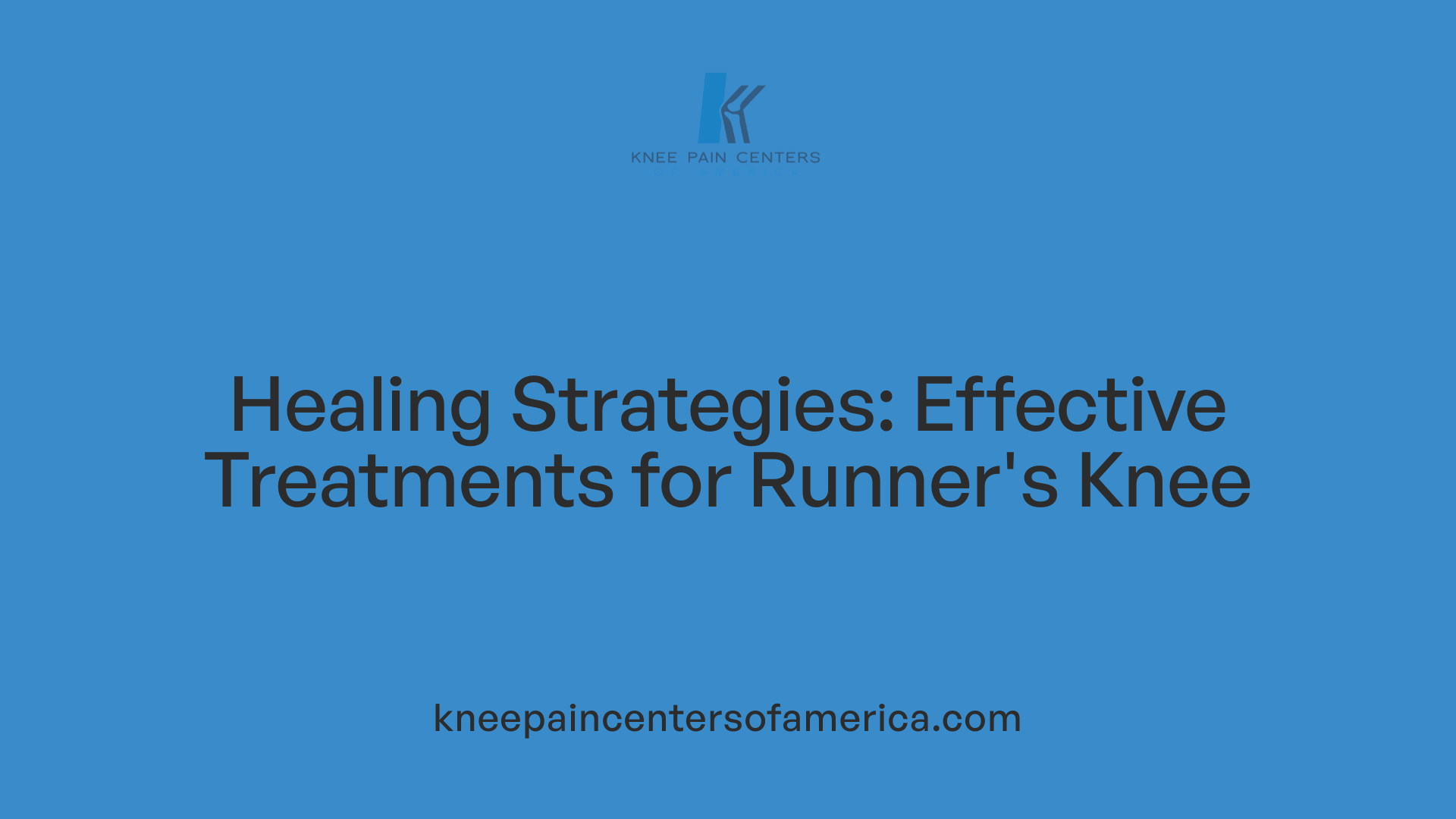Understanding Runner's Knee and Its Implications
Runner's knee is a prevalent condition among athletes, particularly those who engage in repetitive running activities. Known medically as patellofemoral pain syndrome (PFPS), it encompasses various knee issues that result in pain specific to the front of the knee. Despite its name, runner's knee doesn't only afflict runners; it can affect anyone who frequently bends their knees. This comprehensive guide will explore effective methods for prevention, diagnosis, and treatment, aiming to equip you with practical strategies to address and understand knee pain related to running.
Pinpointing Runner's Knee Symptoms and Causes for Diagnosis

Symptoms of runner's knee
Runner's knee, clinically referred to as patellofemoral pain syndrome (PFPS), commonly manifests as a dull pain located at the front of the knee or around the kneecap (patella). Activities like running, squatting, or navigating stairs can intensify this discomfort. Pain can worsen after prolonged periods of sitting with bent knees. Additional symptoms may include swelling, a grinding or popping sensation during movement, and tenderness around the kneecap.
Common causes
Several factors can lead to the development of runner's knee. The most prevalent include:
- Overuse from repetitive knee bending: Activities like running or excessive stair climbing can create wear and tear.
- Trauma or direct hits to the knee: Injury from falls or collisions.
- Malalignment of the kneecap: An improperly aligned patella can cause friction.
- Foot issues: Conditions like flat feet or overpronation can exacerbate stress on the knee.
- Muscle weaknesses: Undeveloped or unbalanced thigh muscles can alter knee mechanics.
- Chondromalacia patella: This involves the breakdown of cartilage under the kneecap, contributing to pain.
How diagnoses are made
Diagnosing runner's knee typically involves a comprehensive physical examination by a healthcare professional who assesses knee function, alignment, and pain response during specific movements. If required, imaging tests such as X-rays may be conducted to evaluate the condition of the knee joint and rule out other potential injuries or issues. This thorough approach ensures an accurate diagnosis and a tailored treatment plan.
Prevention Strategies to Keep Knee Pain at Bay

How can runners prevent knee pain?
Preventing knee pain is crucial for maintaining a sustainable running routine. Runners can adopt a comprehensive approach that focuses on several key areas:
Warm-up and Stretching: Performing a proper warm-up is vital. Engaging in dynamic stretches increases blood flow and prepares the muscles around the knees. Static stretches after running can enhance flexibility. Target key muscle groups such as the quadriceps, hamstrings, and calves. Holding stretches for at least 30 seconds is recommended to effectively lengthen the muscles.
Running Footwear and Form: Selecting appropriate running shoes is essential for knee support. Shoes should offer good cushioning and fit well to prevent misalignment leading to knee pain. Consider a gait analysis for the best shoe fit. Additionally, focus on maintaining proper running form by keeping an upright posture and landing softly to minimize impact on the knees. Regularly replacing shoes every 300-500 miles can help maintain optimal support.
Training Progression and Lifestyle Adjustments: Gradually increase training intensity and distance, following the 10% rule to allow the body to adapt and reduce the risk of overuse injuries. Cross-training with low-impact activities like cycling or swimming can enhance overall strength without straining the knees. Staying hydrated supports muscular function, while maintaining a healthy body weight decreases stress on the knees, contributing to better joint health.
By focusing on these strategies, runners can better safeguard their knees against pain and keep enjoying their running journey.
Common Injuries and Their Impact on Running

What is Patellofemoral Pain Syndrome?
Patellofemoral pain syndrome, commonly known as runner's knee, involves pain around or behind the kneecap. This condition often develops due to muscle imbalances or overuse, and it affects both casual joggers and serious runners alike. Symptoms include a dull ache that worsens with activities such as climbing stairs, squatting, or sitting for long periods.
Understanding IT Band Syndrome
Iliotibial Band Syndrome (ITBS) can cause pain on the outer side of the knee, typically resulting from overuse and poor running mechanics. Tightness or improper tracking of the iliotibial band, which runs along the outside of the thigh, can lead to irritation and inflammation at the knee joint, limiting mobility and causing discomfort.
What is Patellar Tendonitis?
Patellar tendonitis, another common overuse injury, presents as pain at the bottom of the kneecap. Often striking younger athletes, especially those involved in jumping sports, it may occur due to rapid increases in activity intensity. Treatment generally involves strengthening and stretching exercises focusing on the quads and hamstrings.
Why might beginners experience knee pain after running?
Beginners may experience knee pain after running due to several factors, with one of the most common issues being Patellofemoral Pain Syndrome (Runner's Knee), which causes pain around the kneecap during or after exercise. Overuse injuries can occur if beginners increase their mileage or intensity too quickly, placing undue strain on the knee joints. Poor biomechanics, such as improper running form or weakness in stabilizing muscles, can also lead to increased stress on the knees. Other potential causes include tendonitis and inflammation in specific areas, such as the iliotibial band or patellar tendon. To help prevent knee pain, it's important for beginners to focus on proper footwear, warm-ups, and gradually increase their training intensity while incorporating strength and flexibility exercises.
Effective Treatments and Practices for Runner's Knee

What are the treatment options for runner's knee?
Treatment options for runner's knee, also known as patellofemoral pain syndrome, involve several approaches aimed at relieving pain and promoting healing. Rest is vital, allowing the knee to recover by avoiding aggravating activities such as running or squatting.
Ice therapy is effective for reducing swelling and pain; it should be applied for 20-30 minutes every few hours.
Strengthening and stretching exercises, particularly for the quadriceps and hip muscles, are advised, often guided by a physical therapist. Compression wraps, elevating the leg, and taking NSAIDs like ibuprofen can also alleviate discomfort. Utilizing custom orthotics and ensuring appropriate footwear may improve alignment and support during activities. If symptoms persist, it may be necessary to consult a specialist or orthopedic surgeon for further evaluation.
What is the fastest way to heal runner's knee?
The quickest way to heal runner's knee, or patellofemoral pain syndrome, is combining rest, ice application, compression, and elevation, commonly referred to as the PRICE method. Limiting activities that stress the knee, such as running or climbing stairs, is crucial.
Over-the-counter NSAIDs, like ibuprofen, can reduce pain and inflammation. Incorporating targeted stretching and strengthening exercises for the thigh muscles, particularly the quadriceps, is essential for recovery and preventing future issues. Consulting a healthcare professional for a personalized treatment plan, including potential physical therapy, is also beneficial.
| Treatment Method |
Description |
Key Benefits |
| Rest |
Avoid aggravating activities |
Promotes recovery |
| Ice Therapy |
Apply ice for 20-30 minutes |
Reduces pain and swelling |
| Compression Wraps |
Wrap the knee for support |
Provides stability |
| NSAIDs |
Over-the-counter pain relievers |
Alleviates pain and inflammation |
| Strengthening Exercises |
Targeting thigh and hip muscles |
Improves stability and reduces pain |
| Footwear Improvements |
Use custom orthotics and proper shoes |
Enhances alignment and support |
Rehabilitation and Exercise Recommendations

What physiotherapy exercises are recommended for runner's knee?
For runner's knee, a variety of physiotherapy exercises can be beneficial. Recommended exercises include:
- Heel cord stretches: Lengthens the calf muscles to improve ankle movement.
- Standing quadriceps stretches: Targets the front thigh muscles.
- Supine hamstring stretches: Aids in flexibility of the hamstrings.
- Half squats: Strengthens both the quadriceps and hamstrings with less strain.
- Hamstring curls: Focuses on strengthening the hamstrings specifically.
- Calf raises: Aids in strengthening the calves for better overall stability.
- Leg extensions: Isolates and builds strength in the quadriceps.
- Mini squats: Promotes mobility and strength in a controlled manner.
Performing a well-structured conditioning program for 4 to 6 weeks can improve mobility, strength, and flexibility in the knee joint. Additionally, stretching exercises like side leg raises, single-leg lifts, and various stretches are important for relieving pain and addressing muscular imbalances. It's crucial to perform these exercises under the supervision of a healthcare professional to ensure safety and effectiveness.
Importance of physiotherapy
Physiotherapy plays a vital role in the rehabilitation process for runners suffering from knee pain. A tailored physiotherapy program can help not only in alleviating current symptoms but also in preventing future injuries. Physiotherapists can guide patients through proper mechanics of movement and exercise, making sure they regain strength without risking further damage to the knee.
Monitoring progress and avoiding setbacks
Monitoring progress during rehabilitation is essential to achieving a full recovery. Runners should keep track of pain levels and functionalities, noting any discomfort during exercises. Gradually increasing the workload and sticking to recommended recovery timelines can help avoid setbacks. It's crucial to listen to one’s body and consult with healthcare providers if pain occurs, ensuring the journey to recovery is effective and safe.
Recovery Timeline and Guidance
How long does it typically take to recover from runner's knee?
Recovering from runner's knee typically takes between 4 to 8 weeks, depending on the severity of the injury and the effectiveness of the treatment.
- Early intervention: In some cases, with prompt care, recovery can occur in as little as 2 weeks.
- Delayed care: Conversely, neglecting proper treatment may postpone recovery to several months.
A structured rehabilitation program that includes rest, ice, compression, and elevation (the RICE method), combined with specific strengthening exercises, is crucial for healing. Pain serves as a guide to resuming physical activities, so individuals should return to running only when they are completely pain-free.
Factors influencing recovery
Several factors can influence the recovery timeline:
- Severity of the injury: Milder cases often resolve more quickly.
- Adherence to treatment: Following prescribed rehabilitation routines can enhance recovery speed.
- Individual health status: Overall fitness level, body weight, and age may impact healing.
Signs of progress
Monitoring symptoms is essential for gauging recovery:
- Diminished pain levels during daily activities.
- Increased range of motion in the knee.
- Enhanced strength in the surrounding muscles.
If symptoms persist beyond 8 weeks, consulting a medical professional is advised to rule out other potential knee conditions.
Essential Stretches to Alleviate Runner's Knee
What stretches are effective for relieving runner's knee?
To relieve runner's knee, several effective stretches and exercises are recommended. These include the Hamstring Stretch, where you lie on your back and gently pull one leg toward you, holding for around 30 seconds. This movement enhances flexibility in the back of the thigh and can ease knee tension.
The Standing Quad Stretch is another beneficial exercise. By pulling your foot toward your glutes while standing and maintaining balance, you alleviate tightness in the thigh muscles, which is crucial for knee comfort.
Incorporating IT Band Foam Rolling is advantageous; it helps relieve tension along the iliotibial band, thus enhancing mobility and reducing pain in the knee area.
How can I incorporate stretches into my routine?
Additional beneficial exercises include Clamshells, which strengthen the hip muscles, and Straight Leg Raises, focusing on the quadriceps. Wall Squats can also be integrated into your routine to strengthen the quadriceps while minimizing stress on the knees.
Ensure that each stretch is performed gently without pushing through pain. These exercises not only provide immediate relief but can be incorporated into a warm-up or cool-down, promoting lasting benefits for knee health.
Achieving Pain-Free Running
With diligent care and informed strategies, knee pain doesn't have to sideline your running passion. By understanding the underlying causes of runner's knee and implementing best practices in treatment and prevention, you can mitigate existing discomfort and reduce the likelihood of future injuries. Remember to listen to your body and prioritize joint health, allowing you to enjoy the numerous benefits of running safely and effectively.
References